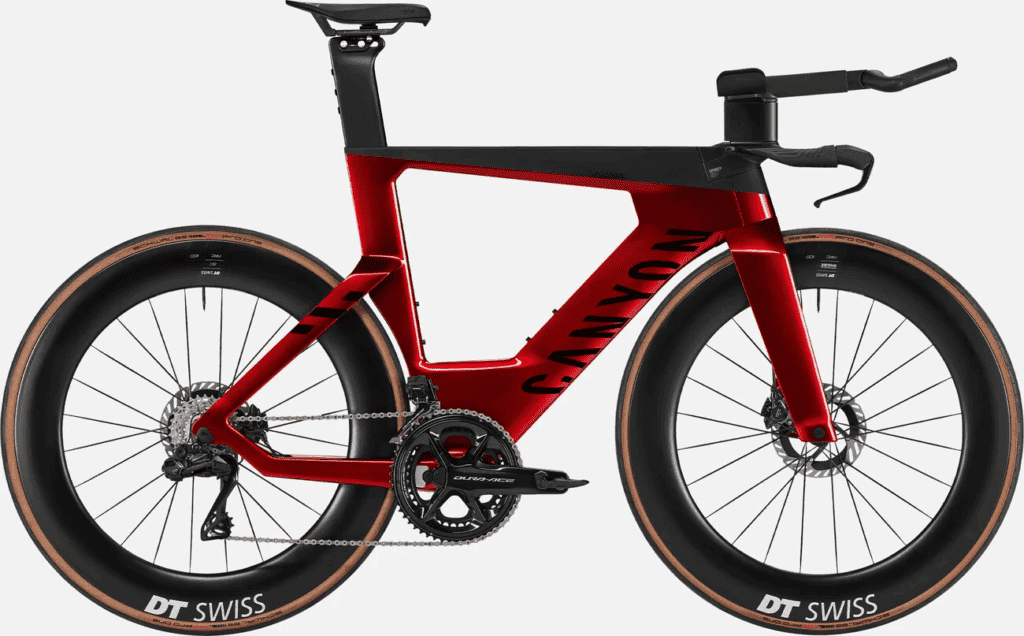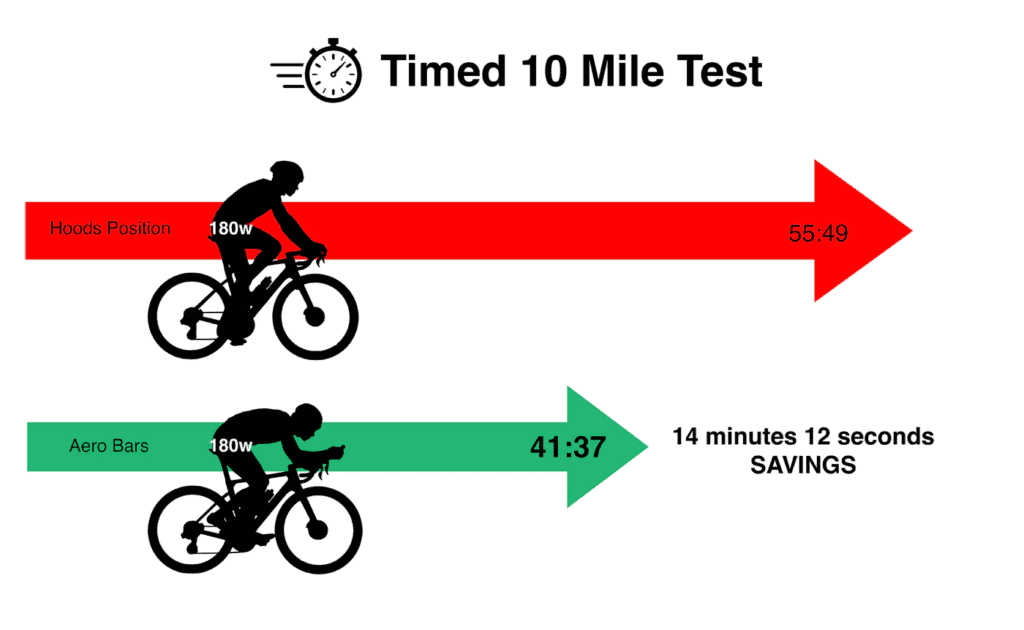Why Triathlon Bikes Are Different (And Better?)
At first glance, a triathlon bike might just look like a sleek, high-end road bike.
However, a closer look reveals a world of design features specifically tailored for speed, efficiency, and comfort during long-distance triathlons. Whether you’re gearing up for your first triathlon or aiming to compete at the Ironman World Championships, understanding the key differences between triathlon bikes and regular road bikes can be your best opportunity to optimize performance.
So, buckle up (or should we say, clip in?), and let’s find out why triathlon bikes are different!
Why Triathlon Bikes are Different Than Road Bikes
Riding a triathlon bike versus a road bike may seem similar, but there are crucial differences between tri bikes and road bikes.
The main difference is the geometry of the frame.
Triathlon bikes are designed for a more aerodynamic position required for riding a triathlon, with a much steeper seat tube angle to put the rider in a more aero position.
In contrast, road bikes typically have a more traditional geometry better suited for road cycling. Additionally, tri bikes often feature aerobars for better aerodynamics during a cycle, while road bikes may have drop handlebars for more hand placements.
Another key difference is the type of handlebar on each type of bike. If you’re a beginner looking to try a tri bike, you may be able to simply add clip-on aerobars to your road bike for training in the aero position. However, for serious triathlon competitors, investing in a dedicated triathlon bike will provide the best performance on triathlon courses. That’s because most triathlon courses are designed for aerodynamics, requiring the rider to maintain a specific aerodynamic position throughout the bike course.
The Anatomy of a (TT) Triathlon Bike

A triathlon bike (time trial bike) is designed with a specific focus on aerodynamics, comfort, and efficiency over long distances, this sets them apart from other types of bikes like traditional road bikes or a mountain bike. Here are several key reasons why triathlon bikes are different:
Aerodynamics
A Triathlon Bike is engineered for optimal aerodynamics to reduce wind resistance.
They have a more aggressive frame geometry, with the seat tube angle positioned to push the rider forward over the bottom bracket. This design reduces the frontal area exposed to the wind, making the rider and bike more aerodynamic. The frames, handlebars, and wheels are also designed to minimize drag.
Riding Position
The geometry of a triathlon bike places the rider in a forward-leaning position, which is more aggressive than on a road bike. This position helps to open up the hip angle, making it more comfortable for the rider to maintain over long distances and facilitating a smoother transition to the running segment of the triathlon. It also helps in engaging different muscle groups, preserving the muscles used in running. Incorporating strength training into your triathlon training can help you get stronger legs for your rides.
Integrated Storage
Triathlon bikes often come with integrated storage solutions for hydration and nutrition, which are essential during long races. These integrated systems are designed to be aerodynamic and easily accessible, allowing athletes to stay fueled and hydrated without significantly disrupting their aerodynamic position.
Bar-End Shifters
Many tri bikes are equipped with bar-end shifters on the aero bars, allowing riders to change gears without moving their hands from the aerodynamic position. This feature helps maintain consistent speed and aerodynamics.
Bar Length and Brake Levers
Triathlon bikes feature specialized bars that provide easy access to brake levers from the aero position. The base bar and aero bars are designed for both comfort during long-distance events and ease of use. Unlike road bike frames, where brake levers are integrated into the handlebars, tri bikes often have them at the end of the aero bars for better position control.
Disc Brakes vs. Rim Brakes
Disc brakes, now common in triathlon frames and compliant with Union Cycliste Internationale (UCI) regulations, offer more reliable stopping power in all conditions, a key advantage on a hilly course or during unexpected rain. While typical road bikes and aero road bikes might still use rim brakes, the trend towards disc brakes is clear for its superior control and safety.
Disc Wheels and Aero Wheels
To further reduce drag, triathlon bikes often use disc wheels or deep-section aero wheels. These wheels are designed to cut through the air more efficiently, offering a significant aerodynamic advantage, especially at higher speeds.
Frame Materials and Construction
The frame materials are one of the most important factors. They’re focused on creating a lightweight yet stiff frame.
This ensures efficient power transfer from the rider to the bike, crucial for maintaining speed over long distances.
Carbon fiber is the material of choice for triathlon bikes, due to its lightweight and ability to be molded into aerodynamic shapes. This material helps in achieving a design that offers both speed and durability.
Speed vs. Comfort: The Great Trade-off
The primary distinction between triathlon (TT) bikes and road bikes lies in their optimization for speed versus comfort.
Triathlon bikes prioritize speed and aerodynamics with features like integrated aero bars and a forward riding position. This design minimizes air resistance, allowing for faster speeds on flat and straight courses typical of triathlons.
However, this speed comes at the cost of comfort, as the aggressive riding position can be challenging to maintain over long distances without proper conditioning and training.
Road bikes, on the other hand, offer a more versatile and comfortable ride. Their design accommodates a wide range of riding conditions with a focus on lightweight frames, shock absorption, and multiple hand positions provided by drop handlebars.
This makes road bikes ideal for varied terrains, including city streets and mountainous areas, offering a smoother ride with more flexibility in riding posture.
Which Bike is Better for a Triathlete?

For triathletes, the choice between a triathlon bike and a road bike depends on several factors, including:
- The type of races they participate in
- Their level of experience
- And personal comfort preferences
Triathlon bikes are undoubtedly the better choice for athletes focused solely on triathlon racing, where the aerodynamic benefits can shave off significant time from the bike segment.
The specific design of time-trial bikes allows athletes to conserve energy by reducing drag, which can be crucial for the subsequent running portion of the race.
Also:
When the bike course is rather flat: Go for a Triathlon Bike
When the course is hilly: A Road bike is the better option
Because the only significant difference will become visible over long and flat rides.
The Best Beginner Triathlon Bikes
Choosing the best beginner triathlon bike involves looking for key features that offer the best option for comfort, speed, and efficiency. Look for a bike with a geometry that supports a more forward and aerodynamic position, disc brakes for reliable stopping power, and easy access to water bottles and nutrition, which are crucial during long-distance events.
Making the Choice
When deciding between a triathlon bike and a road bike, consider your racing goals, budget, and the courses you plan to compete on.
If your primary focus is on short to medium-distance triathlons and you’re seeking every possible advantage to improve your triathlon bike time, a tri bike is likely the best investment.
However, if you enjoy a variety of cycling activities beyond triathlons or prefer a more comfortable ride, a road bike may be more suitable.
The Hybrid Solution (Aero Bars)
For those who cannot decide or are looking for a middle ground, adding clip-on aero bars to a road bike can offer a temporary or beginner-friendly solution.
This setup allows riders to train in an aerodynamic position without fully committing to a triathlon bike.
The aero bars alone make a HUGE difference in overall triathlon performance!

Why aerodynamics matter at all speeds by Silca Blog.
Over time, as you become more dedicated to triathlon racing, investing in a dedicated TT bike can become a more justifiable decision.
Gearing Up for Your Decision
Investing in the right bike is a significant decision for any triathlete. Research, testing different models, and consulting with experienced racers can provide valuable insights into making the best choice for your individual needs and goals.
What Other Gear Do You Need?
Trisuit
Even a trisuit can make you faster on the bike.
Designed for efficiency, a good tri suit allows athletes to swim, bike, and run without changing outfits, saving precious time in transition. It’s crafted from quick-drying materials to provide comfort and support throughout the race.
And with a good aero tri suit, you’ll be faster than the wind;)
Aero Helmet
A triathlon aero helmet is another critical component for the bike segment. While safety is the primary function, these helmets are also designed to reduce aerodynamic drag. Their streamlined shapes can make a significant difference in speed over the bike course, contributing to overall race time improvements.
Wrapping Up
Triathlon bikes offer unmatched speed and efficiency on race day, embodying the spirit of triathlon races itself. While they may require adjustment and commitment to master, the performance benefits are undeniable. Whether you choose the specialized speed of a triathlon bike or the versatile comfort of a road bike, the most important factor is finding a bike that aligns with your racing aspirations and love for the sport.
Frequently Asked Questions
Does a tri bike really make a difference?
Yes, particularly in long-distance races where aerodynamics plays a critical role in maintaining speed and conserving energy. The specialized design of triathlon bikes is focused on optimizing performance in ways that a regular road bike cannot match.
Can you do a triathlon with a normal bike?
Absolutely. While a triathlon-specific bike has its advantages, many athletes successfully compete using road bikes, especially in shorter distances or as beginners in the sport. The key is effective training and mastering the art of using what you have to its fullest potential.
How much time will a TT bike save me?
The time savings can be significant, depending on the distance of the race and the course profile. Athletes can see improvements ranging from a few seconds to several minutes over longer distances like a half or full Ironman. The aerodynamic efficiency of TT bikes means less effort for more speed, preserving energy for the run.
Why do triathletes use aero bars?
Triathletes use aero bars on their bikes to help them go faster and be more efficient during the cycling portion of a triathlon. By getting into an aerodynamic position on the bike, they can reduce wind resistance and maintain a higher speed. The aero bars allow the rider to lean forward and stretch out their body, putting less strain on their legs and allowing them to conserve energy for the rest of the race.
